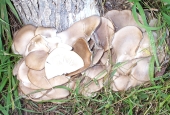Daniel, I finally found what I was looking for in reference to 'summer oysters'.
both the fall and summer oysters have large, well defined stems that are usually offset to one side of the cap and ALWAYS have gills running down the stem.
Summer oyster stems are smaller and can be short, but always present. Mushrooms that appear to be summer oysters but lack a stem are probably Crepidotus species and NOT oysters.
I realize these quotes are taken out of context...both in response to a correct ID on summer oysters where some were surprised at the length of the stem. I'm not familiar with the Crepidotus species that has NO stem.
...by 'smaller' in the second quote I took him to mean 'thin'.
the source is a discussion in Arkansas Wild Foraging and not the mushroom site I thought...same mushroom expert though.
https://www.facebook.com/groups/1834125426696429/
I know that many avoid fb all together but I find the targeted ID discussions a great help.
This was interesting from this site
https://www.mushroom-appreciation.com/oyster-mushroom.html#sthash.sf6zQoDn.dpbs ...it's not one I'm familiar with but I thought the mention of stem growth was interesting...I'll start paying attention to where they are on the log now.
They may not have a stem. If they do it will often be stubby and off-center if the mushroom is growing on the side of a log. If it's growing on the top you will see a more well developed stem.
This has got me wanting to get out in the woods but we usually avoid summer hikes here because of the ticks and it's been so dry..... Over the winter though we brought home at least a meals worth of oysters every time...good food!
and this:
Stem: Sometimes absent or rudimentary, but often present; 1–4 cm long and 0.5–1 cm thick; eccentric or lateral—or central; whitish; bald; basal mycelium white.
https://www.mushroomexpert.com/pleurotus_pulmonarius.html








